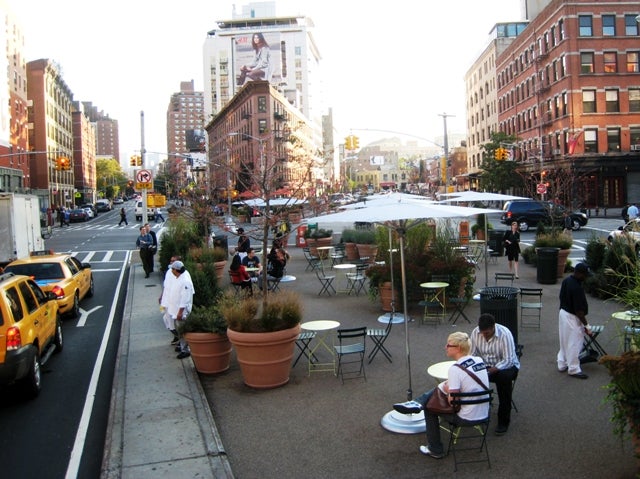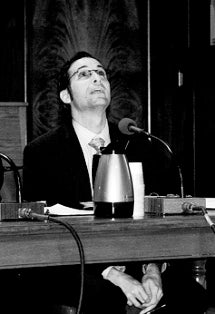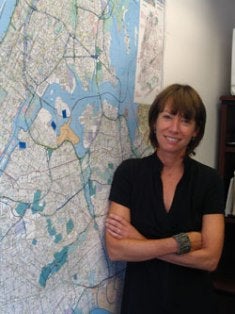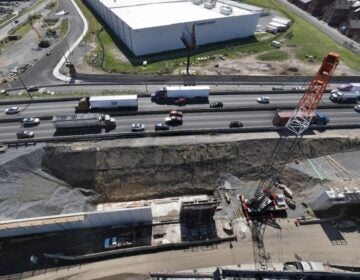Advice from NYC’s bike and pedestrian czar

Transformation: Ninth Ave. and 14th Street
Aug. 28
By Kellie Patrick Gates
For PlanPhilly
The man in charge of making New York City a better place for bicyclists and pedestrians came to Philadelphia yesterday with some advice:
“Perfect is the enemy of done,” said Director of Bicycle & Pedestrian Programs, Ryan Russo.

Ryan Russo
If a city waits until it has the money, time and other resources to bring gorgeous, expensive projects to life exactly as they are on paper, any change will be a long time coming, Russo said at a gathering hosted by Philadelphia’s Office of Transportation. “You gain momentum by getting things on the ground, and when you build momentum, people begin to trust you,” he said.
Russo showed pictures of several less-than-perfect, but people-pleasing projects.
What is now Brooklyn’s Pearl Street Plaza was not long ago just a paved triangle in the middle of three intersecting streets, used for parking cars. There are no new curbs, which would have changed drainage conditions. There was no demolition. One short street that wasn’t really necessary was eliminated. “We brought in planters, tables and chairs,” Russo said. The pavement was painted green, and outlined with typical white, street-marking stripes – a cheap option that Russo’s department often utilizes to change traffic patterns without spending a lot of money.
Some projects can be done in about a year, he said, but there will always be those that take longer – one ongoing project has been in the works for a decade. The pre-work planning always takes time. The bicycle lane projects all tie in to a master plan that was created in 1997, he said.
The city will add 90 miles of bike lane this fiscal year, the last stretch of a three-year, 200-mile push, Russo said.

Janette Sadik-Khan
New York’s bike and pedestrian mission ties into two larger plans – the Department of Transportation’s Strategic Plan and the overall making-the-city-greener document called PlaNYC. These plans wouldn’t have happened without the leadership of Transportation Commissioner Janette Sadik-Khan and Mayor Michael Bloomberg, Russo said.
Russo said every project he spoke about cost less than $1 million. And rather than waiting for capital expenses to come through, his department paid using its own budget and grants, including federal Congestion Mitigation and Air Quality money.
Rina Cutler, Philadelphia’s deputy mayor for transportation, had never heard of using CMAQ money in such a way. “You bought umbrellas and furniture and tables?” she said. “We’re glad we got you now before you went to jail,” she joked.
A similar project, with slightly different materials, was just completed this week on Broadway, Russo said, and the moment the chairs were set up, people were using them to eat lunch and hold business meetings.
But a story in the New York Times pondered whether it was really safe to have people sitting in a space between traffic lanes. Russo said the grants funding the projects require safety studies, which are not complete. But by looking at police department accident reports, his department has preliminarily concluded that the projects they’ve done have not worsened safety anywhere, and have improved safety in some places.
Islands of seating are not the usual way of doing things – generally speaking, seating areas tend to be more like peninsulas, attached on at least one side to the sidewalk or a building. Sometimes, Russo said, you have to break the rules – or at least push their limits. Traffic experts sometimes worry about such things, when they can’t find them in manuals, Russo said. He advised: Don’t fear the traffic engineer.
Russo’s department has also gone against standard procedure – and made liberal use of street markings – to make room for bicycle lanes.
On 9th Avenue in Chelsea, the transportation department made room for a bike lane and a left-turn lane for cars, all with pavement markings and a few bike lane signs. The bike lane is next to the sidewalk, where parking spaces used to be. Next comes a row of parking places, and finally, the roadway for cars.
At intersections, the parking goes away and is replaced by a left-turn bay – basically, a short turning lane where cars are held until they get a left turn signal.
Yes, this means that cars are turning left across the bike path.
“How do you convince your traffic engineers that that’s safe?” Cutler asked. “And your attorneys?” added Stephen Buckley, her second in command.
For one, the city’s chief traffic engineer thought that the roadway had been overdesigned – in other words, that there was room for a lot more cars than were actually using it, Russo said.
The city also installed special traffic signals to combat this problem. Cars have a red turning arrow forbidding them to move while bicycles have a green signal. The bike signal goes red when the cars get their green turning arrow, he said.
There was little public education about the changes, and how it would all work, Russo said. The quick change to an unfamiliar configuration did confuse people at first, he said. And even now that people know what they are supposed to do, some of them don’t – pedestrians walk in bike lanes, and automobile drivers who don’t want to wait in a turning bay for their arrow turn from the main traffic area.
Russo said another benefit to the traffic-markings and planters approach is that small changes are easier for people to live with – and they can be modified or even un-done if need be.
Change is scary to a lot of people, Russo said. And they can get feisty when that change involves reducing travel lanes or parking spaces – the most common ways to make more room for bicycles and pedestrians in an already-built urban setting.
While the traffic engineers felt Chelsea’s 9th Avenue had more capacity than was needed, “the public didn’t think so,” Russo said.
And public input is important, Russo said, but so is acting against it when you are confident that a project will make things better.
“We’re aggressive,” he said. “People complain that ‘maybe you shouldn’t do this,’ but we do it anyway. But we don’t push it too far. It’s walking the tightrope of being the leader and listening to public opinion.”
Ironically enough, the project Russo’s department has gotten the most guff about is one both the traffic engineers and the residents of the neighborhood were happy with.
“We steamrolled there the least, and now we have the most headaches,” he said.
A community group in the meat packing district had lots of elaborate, expensive plans for improvement. Then they saw a not-perfect, but-now project north of them and wanted to do something like it.
The transportation department listened so closely that they even designed special planters for the project – the residents wanted square, not round.
Traffic studies showed that during the day – even during rush hour – the roadway was “dead,” Russo said. The roadway was narrowed to make room for a pedestrian-friendly plaza.
The trouble is, Gansevoort, with its night-time hot spots and fancy restaurants, gets crazy when other neighborhoods are quieting down.
Smoke from a gyro-seller who moved into the plaza is seeping in to one of the swanky eateries.
“At night, there are six rows of taxis,” Russo said. A taxi stops to let someone out, and the others start honking, to the great consternation of people who live in a residential neighborhood to the south.
The transportation department has to do an after-study, Russo said. And some people are calling for them to put the street back the way it was.
And for the most part, Russo’s department has started in the relatively easy places – those where the roadways have extra capacity that could be used by walkers and bikers instead of cars.
So can Philadelphia put any of these ideas to use? Cutler said she found many of them interesting, and her department will examine them to see what might apply here.
The city does have some streets that have room for more cars than those that actually use them, she said. JFK Boulevard came to mind immediately, but Cutler said she would need to do some work to determine if there are others.
Some things would not be as easy in Philadelphia as in New York, she said. “We’re not New York, we’re a little more parochial,” she said at the end of the program. Afterward, she said that many of Philadelphia’s main streets and roadways are state-owned, not city-owned, and that is not a problem in New York.
The transportation office will be bringing in speakers from other cities to share their knowledge, too, Cutler said. And within weeks, Philadelphia will have someone with a job similar to Russo’s. The city is in final negotiations with a prospective coordinator for bicycles and pedestrians. That person is supposed to start working Sept. 22, and Cutler said she hoped to announce who it is in mid-September.
Contact the reporter at kelliespatrick@gmail.com
Check out Q&A with Ryan Russo here
NYC bike plan link
WHYY is your source for fact-based, in-depth journalism and information. As a nonprofit organization, we rely on financial support from readers like you. Please give today.






